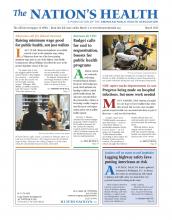When it comes to the calories, sodium and saturated fat per serving in fast food, not much has changed since 1996, according to a recent study.
Published Dec. 31 in Preventing Chronic Disease, the study analyzed sodium, calories, saturated fat and trans fat content between 1996 and 2013 at three major U.S. fast food chains for three items: cheeseburgers, french fries and grilled chicken sandwiches. Calories were also looked at for regular cola soda.
However, there are relatively big differences among fast food restaurants, the study said. Changes in sodium and calorie content varied over time across the chains. For example, a total of 18 percent of the items had lower sodium since 1996, while 33 percent of the items had higher sodium levels. However the changes were modest and not consistent over the 18-year time span, the study said.
Increasing portion size is usually cited as contributing to the obesity epidemic, said study co-author Alice Lichtenstein, DSc, senior scientist and director of the Cardiovascular Nutrition Laboratory at the Jean Mayer United States Department of Agriculture Human Nutrition Research Center on Aging. However, portion size did not seem to be a major factor in the items analyzed in the study, she said.
“Although serving sizes have not changed much over the past decade and a half, the content of calories and sodium in frequently ordered menu items is extremely high,” Lichtenstein told The Nation’s Health. “We need to look at multiple counseling approaches to help people moderate their intake. This might include shifting to new healthier options, ordering fewer items at any one time or taking advantage of the nutrient information now readily available to identify the best options that are close to work or home.”
Additionally, for bundled meals in 2013, such as large-sized meals that came with regular cola soda, a cheeseburger and french fries, a consumer could get anywhere between 63 percent and 91 percent of the 2,300 milligram-per-day of sodium limit recommended by the federal Dietary Guidelines for Americans, depending on the restaurant. A diner could also consume between 65 percent and 80 percent of a 2,000 calorie-per-day diet in 2013, the study said. Nutrition Facts labels are typically based on a 2,000 calorie-per-day diet, according to the Food and Drug Administration.
“Sometimes there’s a price incentive to order a bundled meal,” Lichtenstein said. “Is it really worth the bargain you get if you don’t really need all that food anyway? Individuals need to step back and consider alternate options when ordering. The range of healthier options will expand if people buy them.”
People who want to improve their diet and control their weight should focus less on portion sizes and more on the total number of calories they consume and the number of items they eat, Lichtenstein said. She also recommended health providers encourage their patients to take advantage of online nutrition information either by themselves or with a health care professional to figure out how to make improvements.
For more information, visit www.cdc.gov/pcd/issues/2014/14_0202.htm.
- Copyright The Nation’s Health, American Public Health Association









